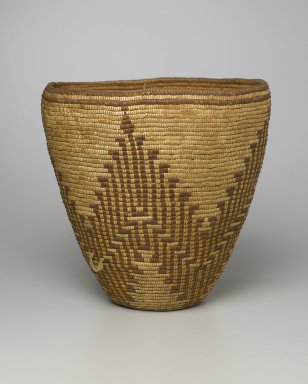
Artist:Klikitat
Medium: Cedar root, bear grass, horsetail root dye, rawhide
Geograhical Locations:
Dates:late 19th or early 20th century
Dimensions: 15 x 15 x 15 in. (38.1 x 38.1 x 38.1 cm)
Collections:
Accession Number: 46.193.1
Image: 46.193.1_PS1.jpg,
Catalogue Description: Basket with an imbricated pattern made from brown bark, yellow bark, and ivory-yellow grass wrapped over cedar root. Imbrication is a regular overlapping arrangement technique that is used exclusively by Native people of the Plateau and Northwest Coast areas. The Klikitat maker used a coil technique that is more like sewing than weaving. Coiled baskets are built up spirally from the center and require two components: the first is a central core of rods or grasses serving as a foundation for the second component which is a group of fibers that simultaneously wrap around the foundation and stitch the coils together. An awl creates holes in the foundation through which fibers are pulled or stitched. While sewing is in process, imbrication decoration is also going forward. Imbrication involves wrapping dyed grasses into the basket, forming an overlapping pattern. The basket is in stable condition.